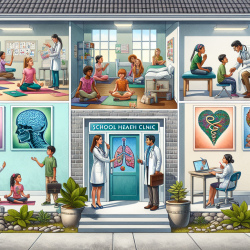Introduction
In recent years, the integration of complementary and alternative medicine (CAM) into school health clinics has gained momentum. The research article "Integrative Health Services in School Health Clinics" by Milosavljevic (2015) highlights the potential of these services to address anxiety and stress in adolescents. This blog explores how practitioners can enhance their skills by implementing integrative health services in school settings, thereby improving outcomes for children.
Understanding Integrative Health Services
Integrative health services combine conventional medical therapies with CAM therapies that have scientific evidence of safety and effectiveness. The focus is on treating the whole person—body, mind, and spirit—while considering individual lifestyles. This holistic approach is particularly beneficial in pediatric populations, where concerns about long-term effects of conventional treatments are significant.
Implementing Integrative Health in Schools
The Integrative Health Program (IHP) initiated in Massachusetts high schools serves as a model for incorporating CAM into school health clinics. The program utilizes three primary modalities: acupuncture, aromatherapy, and sound therapy, all aimed at reducing stress and anxiety among adolescents.
- Acupuncture: This involves stimulating specific points on the body to balance energy flow, which can reduce anxiety symptoms.
- Aromatherapy: The use of essential oils like lavender and grapefruit can have calming effects, reducing stress and promoting relaxation.
- Sound Therapy: Utilizing sound frequencies to promote relaxation and reduce anxiety, sound therapy is a non-invasive and cost-effective approach.
Benefits of School-Based Integrative Health Programs
Implementing integrative health services in schools offers several advantages:
- Reduced barriers to accessing care, as services are provided on-site.
- Lower treatment costs compared to conventional therapies.
- Decreased school absenteeism, as students can receive treatment without leaving school.
- Empowerment of students through education in self-care techniques.
Encouraging Further Research and Implementation
While the IHP has shown promising results, further research is essential to expand the evidence base for CAM therapies in school settings. Practitioners are encouraged to explore integrative health services and consider implementing them in their practice. By doing so, they can contribute to a growing body of evidence supporting the efficacy of these therapies in improving mental health outcomes for adolescents.
Conclusion
The integration of CAM into school health clinics represents a shift towards holistic, patient-centered care. By adopting these approaches, practitioners can enhance their skills and improve outcomes for children, equipping them with lifelong tools to manage stress and anxiety. For those interested in the detailed findings and methodology of the IHP, the original research paper can be accessed here.










